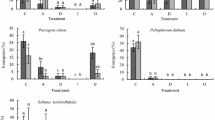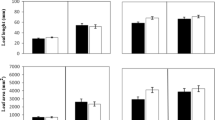Abstract
The decline of arable species characteristic of winter cereal fields has often been attributed to different factors related to agricultural intensification but most importantly to herbicide use. Herbicide phytotoxicity is most frequently assessed using short-term endpoints, primarily aboveground biomass. However, short-term sensitivity is usually not sufficient to detect actual effects because plants may or may not recover over time following sublethal herbicide exposures. Therefore, it is important to assess the long-term effects of herbicide applications. Annual species rely on renewable seed production to ensure their persistence; hence, assessment of herbicide sensitivity is more accurately estimated through effects on reproduction. Here we aim to assess the phytotoxicity of two commonly used herbicides: tribenuron and 2,4-D on eight plant species belonging to four families, each with one rare and one more common species. Specifically we examined the pattern of sensitivity using short-term and long-term endpoints (total aboveground biomass, total seed biomass and number of seeds) of these species; we determined the levels of and time to recovery in terms of stem length and fruit number, and assessed whether their rarity relates to their sensitivity to herbicide application. Our results suggest that although differences in herbicide sensitivity are not a direct cause of rarity for all species, it may be an important driver of declining arable plants.


Similar content being viewed by others
References
Baessler C, Klotz S (2006) Effects of changes in agricultural land-use on landscape structure and arable weed vegetation over the last 50 years. Agric Ecosyst Environ 115:43–50. doi:10.1016/j.agee.2005.12.007
Boutin C, White AL, Carpenter D (2010) Measuring variability in phytotoxicity testing using crop and wild plant species. Environ Toxicol Chem 29:327–337. doi:10.1002/etc.30
Boutin C, Strandberg B, Carpenter D et al (2014) Herbicide impact on non-target plant reproduction: what are the toxicological and ecological implications? Environ Pollut 185:295–306
Breeze V, Thomas G, Butler R (1992) Use of a model and toxicity data to predict the risks to some wild plant species from drift of four herbicides. Ann Appl Biol 121:669–677. doi:10.1111/j.1744-7348.1992.tb03475.x
Carpenter D, Boutin C (2010) Sublethal effects of the herbicide glufosinate ammonium on crops and wild plants: short-term effects compared to vegetative recovery and plant reproduction. Ecotoxicology 19:1322–1336. doi:10.1007/s10646-010-0519-7
Carpenter D, Boutin C, Allison JE (2013) Effects of chlorimuron ethyl on terrestrial and wetland plants: levels of, and time to recovery following sublethal exposure. Environ Pollut 172:275–282. doi:10.1016/j.envpol.2012.09.007
Chamorro L, Romero A, Masalles RM, Sans FX (2007) Cambios en la diversidad de las comunidades arvenses en los cereales de secano en Cataluña. In: Mansilla J, Artigao A, Monreal J (eds) La malherbología en los nuevos Sist. Prod. Agrar. XI Congr. la SEMh. Albacete (Spain), pp 51–55. XI
Clark J, Ortego LS, Fairbrother A (2004) Sources of variability in plant toxicity testing. Chemosphere 57:1599–1612. doi:10.1016/j.chemosphere.2004.07.044
Crone EE, Marler M, Pearson DE (2009) Non-target effects of broadleaf herbicide on a native perennial forb: a demographic framework for assessing and minimizing impacts. J Appl Ecol 46:673–682. doi:10.1111/j.1365-2664.2007.0
Dalton RL, Boutin C (2010) Comparison of the effects of glyphosate and atrazine herbicides on nontarget plants grown singly and in microcosms. Environ Toxicol Chem 29:2304–2315. doi:10.1002/etc.277
De Snoo GR, van der Poll RJ (1999) Effect of herbicide drift on adjacent boundary vegetation. Agric Ecosyst Environ 73:1–6
EFSA Panel on Plant Protection Products and their Residues (EFSA PPR Panel) (2014) Scientific opinion addressing the state of the science on risk assessment of plant protection products for non-target terrestrial plants. EFSA J 12(7):3800. doi:10.2903/j.efsa.2014.3800
Egan JF, Graham IM, Mortensen DA (2014) A comparison of the herbicide tolerances of rare and common plants in an agricultural landscape. Environ Toxicol Chem 33:696–702. doi:10.1002/etc.2491
Environment Canada (2005) Guidance document on application and interpretation of single-species tests in environmental toxicology. EPS 1/RM/46. Methods Dev Appl Sect Environ Technol Cent
Fletcher JS, Ffleeger TGP, Ratsch HCR, Hayes RH (1996) Potential impact of low levels of chlorsulfuron and other herbicides on growth and yield of nontarget plants. Environ Toxicol Chem 15:1189–1196
Follak S, Hurle K (2004) Recovery of non-target plants affected by airborne bromoxynil-octanoate and metribuzin. Weed Res 2003:142–147
Freemark KE, Boutin C (1995) Impacts of agricultural herbicide use on terrestrial wildlife in temperate landscapes: a review with special reference to North-America. Agric Ecosyst Environ 52:67–91. doi:10.1016/0167-8809(94)00534-L
Fried G, Petit S, Dessaint F, Reboud X (2009) Arable weed decline in Northern France: crop edges as refugia for weed conservation? Biol Conserv 142:238–243. doi:10.1016/j.biocon.2008.09.029ER
Grime JP (1979) Plant strategies and vegetation processes. Wiley, Chichester
Hawes C, Haughton AJ, Osborne JL et al (2003) Responses of plants and invertebrate trophic groups to contrasting herbicide regimes in the farm scale evaluations of genetically modified herbicide-tolerant crops. Philos Trans R Soc Lond Ser B 358:1899–1913. doi:10.1098/rstb.2003.1406
Hole DG, Perkins AJ, Wilson JD et al (2005) Does organic farming benefit biodiversity? Biol Conserv 122:113–130. doi:10.1016/j.biocon.2004.07.018ER
Hyvönen T, Salonen J (2002) Weed species diversity and community composition in cropping practices at two intensity levels—a six-year experiment. Plant Ecol 154:73–81
José-María L, Blanco-Moreno JM, Armengot L, Sans FX (2011) How does agricultural intensification modulate changes in plant community composition? Agric Ecosyst Environ 145:77–84. doi:10.1016/j.agee.2010.12.020
Larossa RA, Schloss JV (1984) The sulfonylurea herbicide sulfometuron methyl is an extremely potent and selective inhibitor of acetolactate synthase in Salmonella typhimurium. J Biol Chem 259:8753–8757
Marrs RH, Frost AJ, Plant RA (1991) Effects of herbicide hpray drift on selected species of nature conservation interest: the effects of plant-age and surrounding vegetation structure. Environ Pollut 69:223–235. doi:10.1016/0269-7491(91)90146-N
Organisation for Economic Co-operation and Development (OECD) (2006) Terrestrial plants test: seedling emergence and seedling growth test (no. 2008) and vegetative vigour test (no. 227). OECD Guidelines for the Testing of Chemicals
Pinheiro J, Bates D, DebRoy S, et al (2013) nlme: linear and nonlinear mixed effects models
Qian H, Han X, Peng X et al (2014) The circadian clock gene regulatory module enantioselectively mediates imazethapyr-induced early flowering in Arabidopsis thaliana. J Plant Physiol 171:92–98. doi:10.1016/j.jplph.2013.11.011
R Core Team (2013) R: a language and environment for statistical computing
Riemens MM, Dueck T, Kempenaar C (2008) Predicting sublethal effects of herbicides on terrestrial non-crop plant species in the field from greenhouse data. Environ Pollut 155:141–149. doi:10.1016/j.envpol.2007.10.034
Riemens MM, Dueck T, Kempenaar C et al (2009) Sublethal effects of herbicides on the biomass and seed production of terrestrial non-crop plant species, influenced by environment, development stage and assessment date. Environ Pollut 157:2306–2313. doi:10.1016/j.envpol.2009.03.037
Romero A, Chamorro L, Sans FX (2008) Weed diversity in crop edges and inner fields of organic and conventional dryland winter cereal crops in NE Spain. Agric Ecosyst Environ 124:97–104. doi:10.1016/j.agee.2007.08.002ER
Rotchés-Ribalta R, Blanco-Moreno JM, Armengot L et al (2014) Both farming practices and landscape characteristics determine the diversity of characteristic and rare arable weeds in organically managed fields. Appl Veg Sci. doi:10.1111/avsc.12154
Royo-Esnal A, Recasens J, Montull JM, et al (2011) Sensibilidad de especies mesícolas raras a tratamientos de herbicidas. Plantas invasoras, resistencias a herbicidas y detección de malas hierbas. XIII Congr. la Soc. Española Malherbología. La Laguna, Spain. pp 283–286
Schmitz J, Hahn M, Brühl CA (2014a) Agrochemicals in field margins—an experimental field study to assess the impacts of pesticides and fertilizers on a natural plant community. Agric Ecosyst Environ 193:60–69
Schmitz J, Schäfer K, Brühl CA (2014b) Agrochemicals in field margins—field evaluation of plant reproduction effects. Agric Ecosyst Environ 189:82–91
Storkey J, Meyer S, Still KS, Leuschner C (2012) The impact of agricultural intensification and land-use change on the European arable flora. Proc R Soc B 279:1421–1429. doi:10.1098/rspb.2011.1686
Strandberg B, Mathiassen SK, Bruus M, et al (2012) Effects of herbicides on non-target plants: how do effects in standard plant test relate to effects in natural habitats? Pestic. Res. No 137 Danish Ministry of the Environment EPA, p 114
Taberner A (2013) Herbicides i altres mètodes de control que es poden utilitzar en camps de cereals. In: Serv. Sanit. Veg. Unitat Bones Pràctiques Fitosanitàries i Cober. Veg. http://www20.gencat.cat/docs/DAR/AG_Agricultura/AG02_Sanitat_vegetal/AG02_05_Males_herbes/Documents/Fitxers_estatics/Herbicides_cereal.pdf
Tscharntke T, Klein AM, Kruess A et al (2005) Landscape perspectives on agricultural intensification and biodiversity—ecosystem service management. Ecol Lett 8:857–874. doi:10.1111/j.1461-0248.2005.00782.xER
United States Environmental Protection Agency (USEPA) (2012) Ecological Effects Test Guidelines: Vegetative Vigor. p OCSPP 850.4150
Weed Science Society of America Summary of Herbicide Mechanism of Action According to the Weed Science Society of America (WSSA) (2014). http://wssa.net/wp-content/uploads/WSSA-Mechanism-of-Action. Accessed on 14 Aug 2014
Acknowledgments
We thank Jane Allison, Nayana Dilini de Silva and Jessica Parsons for their assistance in the greenhouse work. This research was funded by the Spanish government through a fellowship to the first author plus a grant during the stage in Canada and by the Projects CGL2009-13497-C02-01 and CGL2012-39442 from the Ministry of Economy and Competitiveness of the Spanish Government, and by Environment Canada.
Conflict of interest
The authors declare that they have no conflict of interest.
Author information
Authors and Affiliations
Corresponding author
Electronic supplementary material
Additional supporting information may be found in the online version of this article. Below is the link to the electronic supplementary material.
10646_2015_1440_MOESM1_ESM.pdf
Annex 1. The non-linear regression logistic models used to calculate IC50, IC25 and IC10. Supplementary material 1 (PDF 13 kb)
10646_2015_1440_MOESM2_ESM.pdf
Annex 2. Summary of the IC50s of the aboveground biomass (Table A2.1) and of the number and biomass of seeds (Table A2.2). Supplementary material 2 (PDF 185 kb)
10646_2015_1440_MOESM3_ESM.pdf
Annex 3. Summary of the IC10s of the aboveground biomass (Table A3.1) and of the number and biomass of seeds (Table A3.2). Supplementary material 3 (PDF 187 kb)
Rights and permissions
About this article
Cite this article
Rotchés-Ribalta, R., Boutin, C., Blanco-Moreno, J.M. et al. Herbicide impact on the growth and reproduction of characteristic and rare arable weeds of winter cereal fields. Ecotoxicology 24, 991–1003 (2015). https://doi.org/10.1007/s10646-015-1440-x
Accepted:
Published:
Issue Date:
DOI: https://doi.org/10.1007/s10646-015-1440-x




